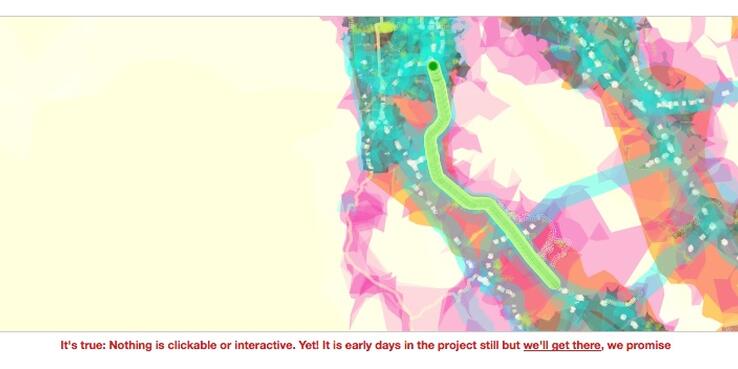When I entered Stamen’s offices in the Mission district of San Francisco, I saw four people gathered around a computer screen. What were they doing? Nothing less than “mapping the world,” not as it appears in flat dimension, but how it reveals itself. And they weren’t joking. Stamen, a data visualization firm, has always kept the concept of “place” central to many of their projects. They achieved this most famously through their crimespotting maps of Oakland and San Francisco, which give geographical context to the world of crime. This week they are taking on a world-sized challenge as they host a conference focusing on cities, interactive mapping, and data.
This conference is part of Stamen’s Citytracking project, funded in part by a Knight News challenge grant. The project is an effort to provide the public with new tools to interact with data as it relates to urban environments. The first part of this project is called dotspotting, and is startling in its simplicity. While still in the early beta stage, this project aims at creating a baseline map by imposing linkable dots on locations to yield data sets. The basic idea is to strike a balance between the free (but ultimately not-yours) nature of Google Maps and the infinitely malleable (but overly nerdy) open-source stacks that are out there.
With government agencies increasingly expected to operate within expanded transparency guidelines, San Francisco passed the nation’s first open data law last fall, and many other US cities have started to institutionalize this type of disclosure. San Francisco’s law is basic and seemingly non-binding. It states that city departments and agencies “shall make reasonable efforts” to publish any data under their control, as long as the data does not violate other laws, in particular those related to privacy. Passed unanimously by the Board of Supervisors, no small feat in this terminally fractious city, departments have been uploading data at a significant rate to our data clearinghouse website, datasf. While uploading data to these clearinghouses is the first step, finding ways to truly institutionalize this process has been challenging.
Why should we care about open data? And why should we want to interact with it?
While some link the true rise of the open data movement with the most recent recession, the core motivation behind this movement has always active citizenship. Open data in this sense can mean the right to understand the social, cultural, and societal forces constantly in play around us. As simultaneously, the largest consumers and producers of data, cities, have the responsibility to engage their citizens with this information. Gabriel Metcalf, executive director of SPUR (San Francisco Planning and Urban Research Association), and I wrote more about this in our 2010 year in review guide.
Stamen’s Citytracking project wants to make that information accessible to more than just software developers but at a level of sophistication that simultaneously allows for real analysis and widespread participation. Within the scope of this task, Stamen is attempting to converge democracy, technology, and design.
Why is this conference important?
Data and Cities brings together city officials, data visualization experts, technology fiends, and many others who fill in the gaps between these increasingly related fields. Stamen also has designed this conference to have a mixture of formats, from practical demonstrations, to political discussions, and highly technical talks. According to Eric Rodenbeck, Stamen’s founder and CEO, “This is an exciting time for cities and data, where the literacy level around visualization seems to be rising by the day and we see huge demand and opportunity for new and interesting ways for people to interact with their digital civic infrastructure. And we're also seeing challenges and real questions on the role that cities take in providing the base layer of services and truths that we can rely on. We want to talk about these things in a setting where we can make a difference.”
Data and Cities will be held February 9th, 10th, and 11th and is invitation only. For the inside scoop, follow my coverage from the conference on PBS Media shift, SPUR’s blog, and Stamen’s blog. We will also be live tweeting from @spur_urbanist and @stamen.
Speakers:
Jen Pahlka from Code for America - inserting developers into city IT departments across the country to help them mine and share their data.
Adam Greenfield from http://urbanscale.org/ and author of Everyware
Jay Nath, City of San Francisco
http://www.jaynath.com/2010/12/why-sf-should-adopt-creative-commons
http://datasf.org
